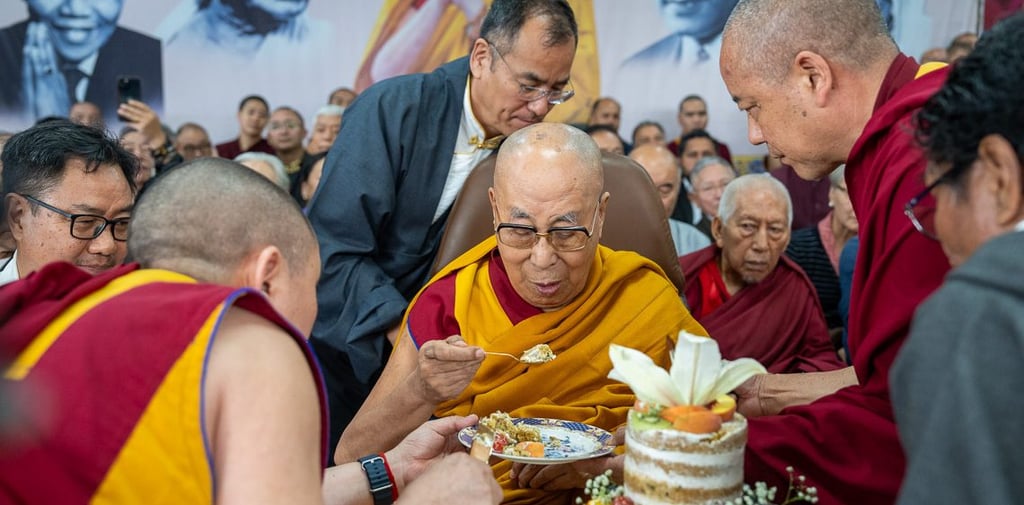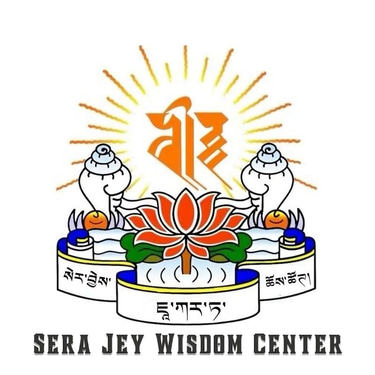The Life of His Holiness the Dalai Lama: A Journey of Peace, Compassion, and Resilience
This blog explores the inspiring life of His Holiness the 14th Dalai Lama—from his humble beginnings in Tibet to becoming a global symbol of peace, compassion, and resilience. It highlights his spiritual journey, peaceful activism, and unwavering dedication to promoting kindness, human values, and unity in a divided world.
7/7/20253 min read


His Holiness the 14th Dalai Lama, Tenzin Gyatso, is one of the most respected spiritual leaders of our time. Born on July 6, 1935, in a small village called Taktser in northeastern Tibet, his birth name was Lhamo Thondup. His journey from a humble farming family to becoming the global symbol of peace and compassion is nothing short of extraordinary. Revered as the reincarnation of his predecessor, the 13th Dalai Lama, Tenzin Gyatso was recognized at the age of two as the next Dalai Lama—an incarnation of Avalokiteshvara, the Bodhisattva of Compassion.
At just five years old, he was formally enthroned and began an intensive monastic education at the Potala Palace in Lhasa, the capital of Tibet. His curriculum included logic, Tibetan art and culture, Sanskrit, medicine, Buddhist philosophy, and more. By the age of 23, he had passed the final Geshe Lharampa exam—the highest-level degree in Buddhist philosophy—demonstrating his deep commitment to intellectual and spiritual development. His early years were shaped by a combination of strict discipline, rigorous study, and a deep sense of responsibility, even at such a young age.
The mid-20th century brought turmoil to Tibet. In 1950, at just 15 years old, the Dalai Lama was thrust into political leadership when the Chinese People's Liberation Army invaded Tibet. For the next several years, he tried to navigate peaceful negotiations with the Chinese government, but tensions continued to escalate. In 1959, a full-scale uprising erupted in Lhasa, and fearing for his life, the Dalai Lama fled Tibet in a dangerous journey across the Himalayas. He eventually found asylum in India, where he established the Tibetan government-in-exile in Dharamshala, which remains its base today.
The flight into exile marked a new chapter in his life. Rather than succumb to despair, the Dalai Lama chose to embrace his role as a global ambassador of peace. He devoted himself to preserving Tibetan culture, advocating for human rights, and promoting interfaith harmony. Through countless speeches, writings, and dialogues, he spread the message of compassion, nonviolence, and inner transformation. His teachings often emphasize that the key to a happy life lies not in material wealth, but in cultivating kindness, mindfulness, and understanding.
Despite the pain of exile and the ongoing suffering of his people, His Holiness has never expressed hatred or bitterness toward China. Instead, he champions what he calls the “Middle Way Approach,” which seeks genuine autonomy for Tibet within the framework of the Chinese constitution. His peaceful advocacy for Tibetan rights has garnered global support, while also earning him international awards—including the Nobel Peace Prize in 1989. The Nobel Committee praised his commitment to peaceful solutions and his opposition to the use of violence, even under extreme circumstances.
His Holiness is also known for his profound sense of humility and humor. Whether addressing global leaders or speaking with schoolchildren, he radiates warmth and simplicity. He often refers to himself as a "simple Buddhist monk" and encourages others to see beyond labels of religion, race, and nationality. To him, the most important identity is that of being human. In his words, “My religion is very simple. My religion is kindness.”
In addition to his spiritual leadership, the Dalai Lama has played a vital role in promoting the intersection of science and spirituality. His collaboration with neuroscientists and psychologists has opened new frontiers in understanding the benefits of meditation, mindfulness, and emotional regulation. Through the Mind and Life Institute, he has supported dialogues that bridge the gap between ancient wisdom and modern science, showing how practices rooted in Buddhism can enhance well-being and cognitive health in secular contexts.
Despite advancing age and health challenges, the Dalai Lama remains active. He continues to meet with world leaders, scholars, and followers from all walks of life, urging people to embrace compassion and work toward a more peaceful world. His digital presence has also grown, allowing him to reach a global audience through livestreams, social media, and online teachings.
Yet, the Dalai Lama’s influence goes beyond politics and religion. He represents the enduring human spirit—a living example of how resilience, love, and forgiveness can prevail even in the face of loss and adversity. His message resonates not only with Buddhists but with people of all faiths and backgrounds. In a world often divided by conflict, he remains a unifying figure, reminding humanity of its shared destiny and collective responsibility.
As he celebrates another year of life, His Holiness continues to inspire generations. From a child in rural Tibet to a global icon of peace, the life of the Dalai Lama teaches us that true leadership is not about power, but about serving others with a compassionate heart. His story is not just the story of a monk or a political figure—it is a story of hope, courage, and the boundless power of compassion.
In honoring the life of the Dalai Lama, we are reminded that even amidst chaos and uncertainty, it is possible to choose peace. It is possible to lead with love. And it is always possible to create a better world—one act of kindness at a time.
Community
Explore teachings, prayers, and cultural events.
Address
Sera Jey Wisdom Center
Ruko Savoy Blok C1 No.31 & 32,
River Garden Jakarta Garden City,
Cakung Timur, Jakarta Timur 13910,
Indonesia
+62 813 2488 4241
© 2025. All rights reserved.
